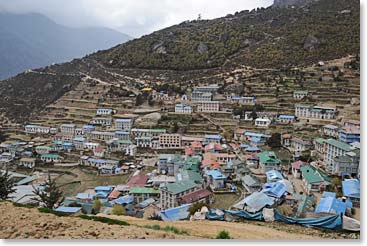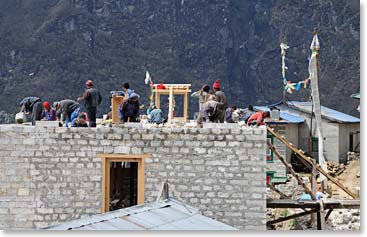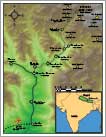
Leo Power Everest Marathon Dispatch
May 18, 2011 – Rest Day in Namche, Nepal 3,450m/11,319ft
Today was an acclimatization day so I spent time reading and walking through the interesting village of Namche.

Namche
Our plan had been to trek up to a Sagarmartha National Park overlook this morning to view Everest, Ama Dablam and Lhotse peaks but the weather was not conducive for such an experience. Hopefully tomorrow I will get to view the exalted summit of Everest!
Namche served as a staging point for traders across Nepal and into Tibet but has evolved into an important base for trekkers heading to Everest base camp or to Lukla or Gokyo.
The architecture is largely modern but faithful to the traditional stone and timber construction techniques, and today I saw two major lodge construction projects and the men were using simple stone cutting/chipping tools, without any safety glasses or gloves, to shape the stones into remarkably uniformly shaped pieces which results in solid and aesthetically pleasing structures.

Traditional stone and timber construction
As Wally Berg wrote "Namche is small, scenic beyond belief, and surprisingly cosmopolitan. It is a mixture of Tibetan traders, tourists from around the world, expedition climbers, proud Sherpas, monks, Nepalese civil servants, dust, mud, colourful costumes, and yaks."
Walking around the village and its cobbled stone streets was an experience and Min and I visited two bookstores and I purchased Sir Edmund Hillary's "View From The Summit" and Michael Palin's "Himalaya".
We then stopped at Liquid Bar which was showing a movie titled "Himalaya" (also known as "Caravan") and it was playing on a battered old screen from a projector mounted on the low ceiling. About 20 people were gathered to watch and I ordered an Everest beer (brewed in Kathmandu since 2003 to celebrate the 50th anniversary of Tenzing's and Hillary's summit of Everest) for Min and I and we watched about an hour of the film.
Next we sauntered over to Namche Bakery and had a tasty piece of apple pie and finally we visited Cafe Daphne where Min and I had another Everest beer and we then headed back to the lodge.
Tonight I'm relaxing at our lodge and tomorrow we will trek for approximately 4 hours to Thame, home of Famed Sherpa Tenzing Norgay who on May 29, 1953, together with Sir Edmund Hillary were the first to summit Mount Everest. Ang Rita has summited Everest 10 times and Apa 18 times and they both call Thame home.
The term trekking is generally understood to describe adventurous walking as opposed to climbing/mountaineering where expedition teams are equipped with serious gear for ascending serious peaks. So one doesn't trek to the summit of Everest but one does trek to Everest base camp.
Tonight my gregarious lodge host Sherab Jangbu has offered me a drink of Rakshi, a local wine made from fermented rice and made today by his wife Lhakpa. Not as strong as my late Grandfather Shea's moonshine but strong enough to ensure moderation!
I omitted to describe some of my experiences while in Kathmandu including a visit to Pashupatinath, a Unesco world heritage site and a Hindu Holy Temple in honour of Lord Shiva, the God of Gods, described as Lord of the entire living beings and the source of eternal bliss and peace.
Both Hindus and Buddhists worship here and it serves as a model for religious harmony. The Bagmati River runs through the centre of the temple and is the equivalent of the Ganges River in India. I witnessed a traditional Hindu cremation ceremony where a family laid the deceased on a funeral pyre, a young son circled the body three times and another family member lit the fire. It takes approximately 3 hours to complete the process of cremation. The ashes are then placed in the river which is carrying on a custom that has existed for thousands of years.
I also had photos taken with a number of Sadhus, a type of Priest, who have renounced all worldly possessions in devotion to Lord Shiva. Scary looking hermits with wildly and colourfully painted faces- one looked like ZZ Top, without the face paint.
My guide Arjun, a Hindu, was fairly animated in describing the sights and scenes at Pashupatinath, but I was happy to leave the filthy surroundings and the polluted Bagmati River.
We then headed to Boudhanath, another Unesco world heritage site in Nepal and an important Buddhist site in Kathmandu and the heart of its Tibetan community. Since the arrival of Tibetan refugees in the 1960s Boudhanath has become the centre of a thriving town of monasteries, craftmanship and businesses.
Boudhanath is an important place of pilgrimage for the Buddhist. Traders, pilgrims and travellers have traditionally sought blessing for safe passage over the mountain passes and gave thanksgiving upon arrival in the Kathmandu valley.
A magical and peaceful place, I highly recommend a visit to Boudhanath.
I also visited the Hanuman-dhoka Durbar Square, yet another Unesco world heritage site, a complex of beautiful temples and shrines, both Hindu and Buddhist.
Kathmandu is well worth a visit. An interesting spectacle is Freak street where pot smoking hippies ruled in the 60s and 70s and Cat Stevens lived here for a year around 1970.
Namaste (generally means hello/goodbye but literally means I salute the divine inside of you- the universal Nepalese greeting).
– Leo Power


